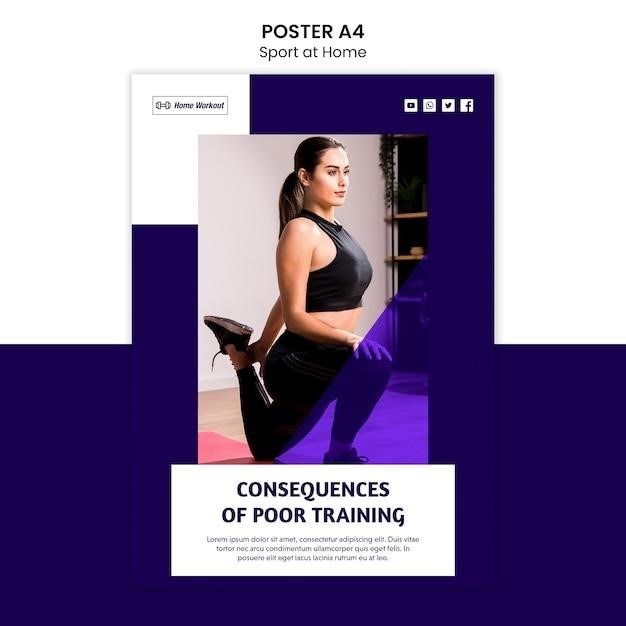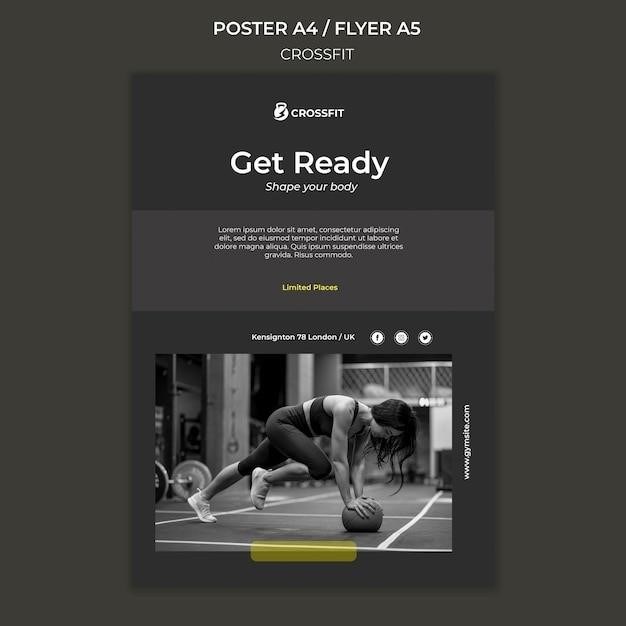Bodyweight Training PDF⁚ A Comprehensive Guide
This guide provides a comprehensive overview of bodyweight training, encompassing beginner routines, advanced techniques, and creating personalized workout plans․ Discover the numerous benefits and explore various exercises, progressions, and resources available in readily accessible PDF formats․ Learn how to build strength and muscle using only your bodyweight․
Introduction to Bodyweight Training
Bodyweight training, also known as calisthenics, leverages your own body weight as resistance for exercise․ Unlike weightlifting, it requires minimal equipment, making it ideal for home workouts or travel․ This method focuses on functional movements, enhancing strength, endurance, and flexibility․ Numerous exercises target various muscle groups, promoting overall fitness․ Beginners can start with simpler variations, gradually progressing to more challenging exercises as strength increases․ Proper form is crucial to prevent injuries and maximize results․ Many free PDFs online offer structured routines, catering to different fitness levels and goals․ These guides often detail exercises, sets, reps, and rest periods for effective training․ Remember that consistency and proper technique are key to achieving your fitness objectives․
Benefits of Bodyweight Workouts for Beginners
Bodyweight training offers numerous advantages for beginners․ Firstly, it’s accessible and affordable, requiring no gym membership or expensive equipment․ This removes financial barriers and allows for consistent workouts at home or outdoors․ Secondly, it builds a strong foundation of functional strength, improving daily life activities․ Exercises like squats and push-ups enhance overall mobility and stability․ Thirdly, it’s adaptable to various fitness levels․ Beginners can modify exercises to suit their capabilities, gradually increasing intensity as they progress․ This reduces the risk of injury and fosters a positive exercise experience․ Finally, bodyweight training improves body awareness and control․ Learning proper form and mastering basic movements enhances coordination and balance․ These benefits make bodyweight training an excellent starting point for a lifelong fitness journey․ Many free PDF workout plans are designed specifically for beginners, guiding them through safe and effective routines․
Sample Bodyweight Workout Routines (Beginner)
Numerous beginner bodyweight workout routines are available online, often presented as downloadable PDFs․ A typical routine might include three workouts per week, focusing on different muscle groups each session․ A sample workout could start with a warm-up of dynamic stretches like arm circles and leg swings․ The workout itself might consist of bodyweight squats (2 sets of 10-12 repetitions), push-ups (as many repetitions as possible, AMRAP), walking lunges (2 sets of 10-12 repetitions per leg), and planks (holding for 30 seconds, 2-3 sets)․ A cool-down of static stretches, holding each stretch for 30 seconds, would follow the workout․ Remember to listen to your body and rest when needed․ Progress gradually by increasing the number of sets, repetitions, or the hold time for each exercise․ Consistency is key; aim for regular workouts, even if it’s just a short session․ Many free PDFs offer detailed instructions and visual guides for proper form, ensuring safe and effective exercise execution․ Remember to consult a healthcare professional before starting any new workout routine․

Creating Your Own Bodyweight Training Plan
Designing a personalized bodyweight training plan involves selecting exercises targeting specific muscle groups, incorporating progressive overload techniques, and structuring workouts for optimal results․ Consider your fitness level and goals when creating your plan․
Choosing Exercises for Different Muscle Groups
To create a well-rounded bodyweight training plan, careful selection of exercises that target various muscle groups is crucial․ For chest development, push-ups (standard, incline, decline variations) and handstand push-ups (advanced) are highly effective․ Back muscles can be strengthened with inverted rows (using a sturdy table or bar), Australian pull-ups, and even bodyweight rows using a sturdy surface․ Legs and glutes benefit immensely from squats (various stances), lunges (forward, reverse, lateral), and jump squats․ Shoulders gain strength and definition through handstand push-ups, pike push-ups, and lateral raises (using resistance bands or similar)․ Core strength is essential and is built up with planks (various holds), side planks, Russian twists, leg raises, and bicycle crunches․ Remember to always prioritize proper form to prevent injuries and maximize results․ Consider the experience level when selecting exercises, starting with easier variations and gradually progressing to more challenging ones․ A diverse range of exercises ensures comprehensive muscle engagement, preventing imbalances and promoting overall fitness․
Progressive Overload Techniques in Bodyweight Training
Progressive overload is paramount for continuous progress in bodyweight training․ It involves gradually increasing the demands placed on your muscles over time, forcing them to adapt and grow stronger․ Several methods achieve this․ Increasing repetitions⁚ Start with a manageable number of repetitions and gradually increase them as you get stronger․ Adding sets⁚ Begin with one or two sets of each exercise and progressively add more sets as your endurance improves․ Increasing the difficulty⁚ Once you can comfortably perform many repetitions, increase the exercise’s difficulty․ This can involve switching to a harder variation (e․g․, from standard push-ups to decline push-ups) or incorporating advanced techniques like plyometrics or isometric holds․ Introducing new exercises⁚ Adding new exercises to your routine introduces new challenges and keeps your muscles engaged․ Using resistance bands or weighted vests⁚ Incorporating external resistance enhances the intensity, aiding further muscle growth and strength gains․ Remember to listen to your body; rest and recovery are vital for muscle growth․ Proper form is essential throughout this progression to avoid injury․ Consistent application of these techniques ensures continued strength and fitness improvement․

Advanced Bodyweight Training Techniques
This section explores advanced calisthenics, including challenging variations of fundamental exercises and complex movements requiring significant strength and control․ Mastering these techniques enhances overall fitness and builds impressive strength․
Calisthenics and Advanced Bodyweight Exercises
Calisthenics elevates bodyweight training beyond basic exercises․ It introduces dynamic movements that challenge balance, coordination, and strength in new ways․ Think muscle-ups, handstand push-ups, and L-sits—exercises demanding significant upper body strength, core stability, and precise technique․ These advanced moves are not for beginners; they require a solid foundation in fundamental bodyweight exercises․ Before attempting these advanced calisthenics, ensure proper form in simpler exercises to prevent injury․ Progressive overload, gradually increasing the difficulty of exercises, is crucial․ This might involve increasing repetitions, sets, or holding advanced positions for longer durations․ Consider incorporating variations like plyometrics (explosive movements) to add intensity․ For instance, clapping push-ups or box jumps build explosive power․ Remember, proper form is paramount to avoid injury and maximize results․ Consult reputable fitness resources and consider professional guidance if needed․ Consistency and patience are essential keys to mastering these challenging yet rewarding exercises․
Workout Progressions and Variations
To avoid plateaus and maximize results, incorporate progressions and variations into your bodyweight training․ This involves systematically increasing the challenge of exercises to continually stimulate muscle growth and strength gains․ Simple progressions for squats might include adding weight via a weighted vest, transitioning from regular squats to pistol squats, or incorporating jump squats for explosive power․ Push-ups can be modified by changing hand placement (wider or closer) or elevating your feet․ For pull-ups, you could progress from assisted pull-ups using resistance bands to full unassisted pull-ups․ Variations add excitement and target muscles differently․ For example, instead of standard lunges, try walking lunges, lateral lunges, or curtsy lunges․ Plank variations include side planks, forearm planks, or planks with leg raises․ Remember, the key is to choose progressions and variations that challenge you while maintaining correct form․ Don’t rush the process; focus on quality over quantity․ Regularly reassess your progress and adjust your routine as needed․ These strategic adjustments will keep your workouts engaging and prevent stagnation․
Utilizing Bodyweight Training PDFs
Bodyweight training PDFs offer structured workout plans, exercise demonstrations, and progression guidance․ Choose reputable sources for accurate information and safe exercise execution․ Many free and paid resources are available online․
Finding Reputable Bodyweight Training PDFs Online
Locating trustworthy bodyweight training PDFs requires careful consideration․ Look for PDFs from certified fitness professionals, reputable fitness websites, or established organizations․ Check for credentials and experience of the authors; avoid sources lacking verifiable expertise․ Examine the PDF’s content for clarity, comprehensive exercise instructions, and safety precautions․ A well-structured PDF will include detailed descriptions of each exercise, visual aids like diagrams or videos (if embedded or linked), and modifications for different fitness levels․ Be wary of overly simplistic or overly complex programs; a balanced approach is key․ Read reviews and testimonials from other users if available to gauge the PDF’s effectiveness and safety; Consider the program’s overall design⁚ does it incorporate progressive overload, rest periods, and a balanced approach to different muscle groups? A reputable PDF will prioritize proper form and injury prevention, making your safety a priority․



